Activity-Based Costing: Implementation and Challenges
VerifiedAdded on 2023/03/20
|10
|2235
|64
Essay
AI Summary
This essay provides a comprehensive analysis of Activity-Based Costing (ABC) in management accounting. It begins by defining ABC and highlighting its advantages over traditional costing methods, particularly in diverse and automated environments. The essay then explores the application of ABC across various industries, including manufacturing, healthcare, and consumer goods, supported by real-world examples such as Nestle and Atlas Electronics. It delves into the benefits of ABC, such as improved cost allocation, accurate product costing, and enhanced decision-making for managers. The essay also examines the factors that may hinder the widespread adoption of ABC, such as the time-consuming and costly data collection process, and the limitations of ABC in smaller organizations. The essay concludes by emphasizing the effectiveness of ABC in reducing overhead costs and improving profitability, while acknowledging that its successful implementation depends on the size and type of the organization, as well as the availability of accurate data.

Management Accounting for Non-Accountants
5/13/2019
5/13/2019
Paraphrase This Document
Need a fresh take? Get an instant paraphrase of this document with our AI Paraphraser
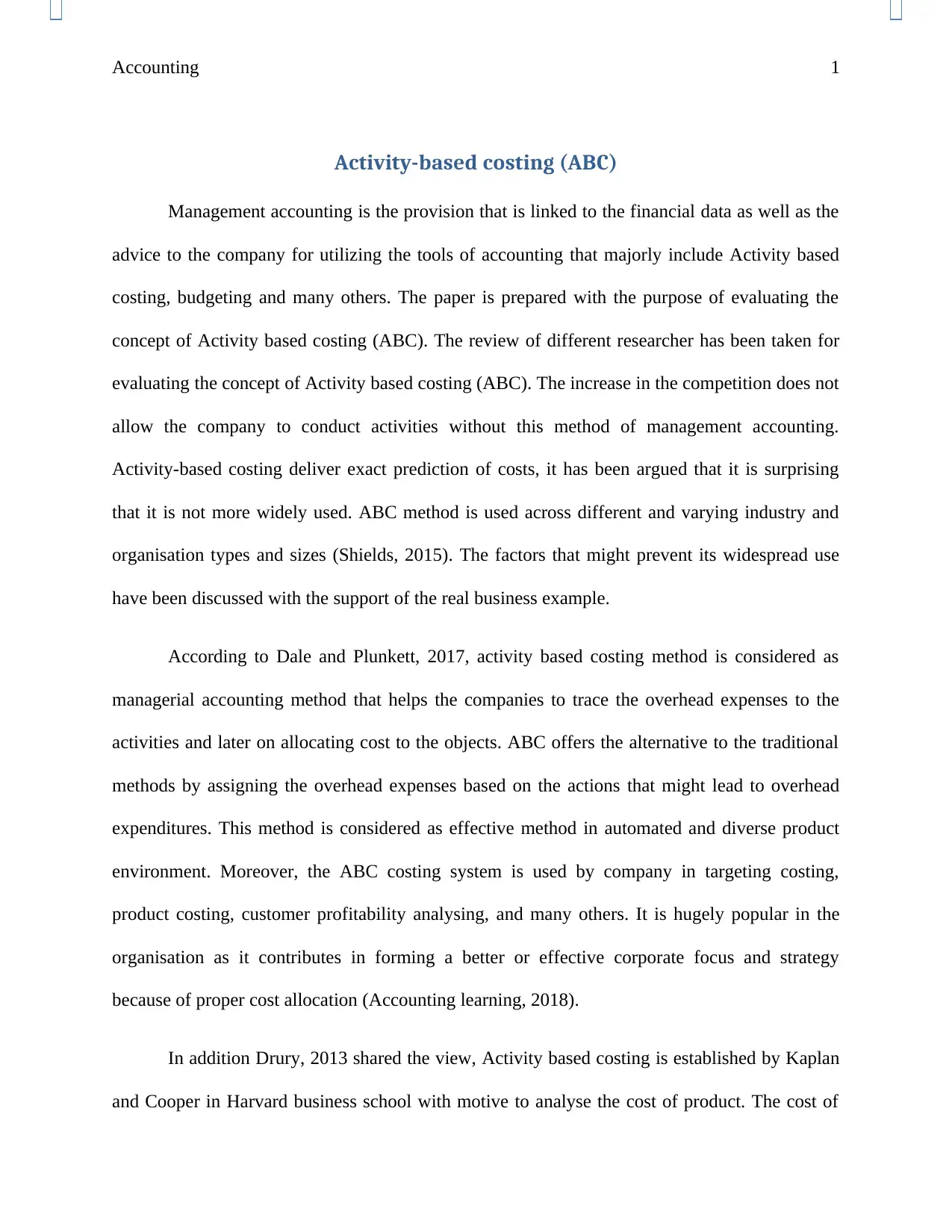
Accounting 1
Activity-based costing (ABC)
Management accounting is the provision that is linked to the financial data as well as the
advice to the company for utilizing the tools of accounting that majorly include Activity based
costing, budgeting and many others. The paper is prepared with the purpose of evaluating the
concept of Activity based costing (ABC). The review of different researcher has been taken for
evaluating the concept of Activity based costing (ABC). The increase in the competition does not
allow the company to conduct activities without this method of management accounting.
Activity-based costing deliver exact prediction of costs, it has been argued that it is surprising
that it is not more widely used. ABC method is used across different and varying industry and
organisation types and sizes (Shields, 2015). The factors that might prevent its widespread use
have been discussed with the support of the real business example.
According to Dale and Plunkett, 2017, activity based costing method is considered as
managerial accounting method that helps the companies to trace the overhead expenses to the
activities and later on allocating cost to the objects. ABC offers the alternative to the traditional
methods by assigning the overhead expenses based on the actions that might lead to overhead
expenditures. This method is considered as effective method in automated and diverse product
environment. Moreover, the ABC costing system is used by company in targeting costing,
product costing, customer profitability analysing, and many others. It is hugely popular in the
organisation as it contributes in forming a better or effective corporate focus and strategy
because of proper cost allocation (Accounting learning, 2018).
In addition Drury, 2013 shared the view, Activity based costing is established by Kaplan
and Cooper in Harvard business school with motive to analyse the cost of product. The cost of
Activity-based costing (ABC)
Management accounting is the provision that is linked to the financial data as well as the
advice to the company for utilizing the tools of accounting that majorly include Activity based
costing, budgeting and many others. The paper is prepared with the purpose of evaluating the
concept of Activity based costing (ABC). The review of different researcher has been taken for
evaluating the concept of Activity based costing (ABC). The increase in the competition does not
allow the company to conduct activities without this method of management accounting.
Activity-based costing deliver exact prediction of costs, it has been argued that it is surprising
that it is not more widely used. ABC method is used across different and varying industry and
organisation types and sizes (Shields, 2015). The factors that might prevent its widespread use
have been discussed with the support of the real business example.
According to Dale and Plunkett, 2017, activity based costing method is considered as
managerial accounting method that helps the companies to trace the overhead expenses to the
activities and later on allocating cost to the objects. ABC offers the alternative to the traditional
methods by assigning the overhead expenses based on the actions that might lead to overhead
expenditures. This method is considered as effective method in automated and diverse product
environment. Moreover, the ABC costing system is used by company in targeting costing,
product costing, customer profitability analysing, and many others. It is hugely popular in the
organisation as it contributes in forming a better or effective corporate focus and strategy
because of proper cost allocation (Accounting learning, 2018).
In addition Drury, 2013 shared the view, Activity based costing is established by Kaplan
and Cooper in Harvard business school with motive to analyse the cost of product. The cost of
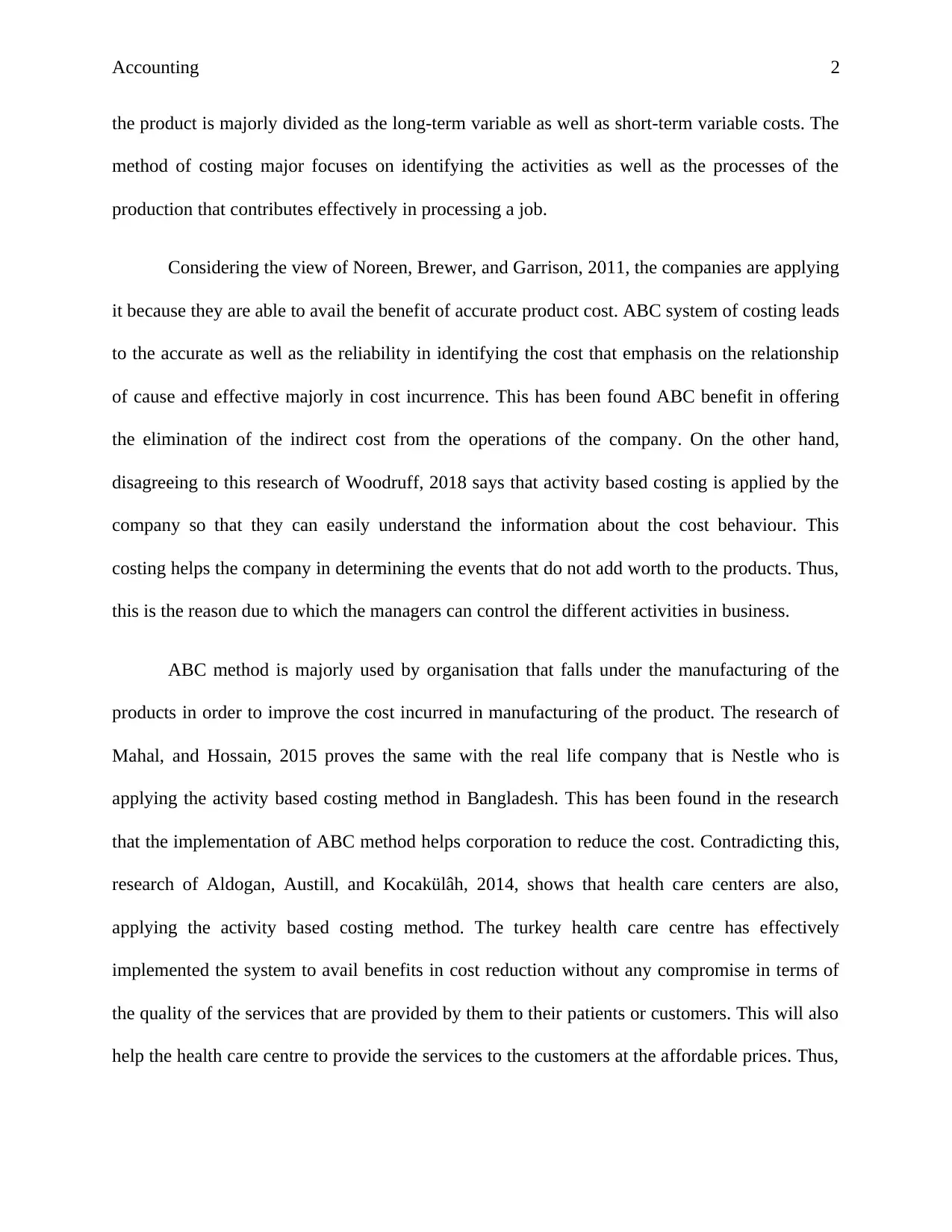
Accounting 2
the product is majorly divided as the long-term variable as well as short-term variable costs. The
method of costing major focuses on identifying the activities as well as the processes of the
production that contributes effectively in processing a job.
Considering the view of Noreen, Brewer, and Garrison, 2011, the companies are applying
it because they are able to avail the benefit of accurate product cost. ABC system of costing leads
to the accurate as well as the reliability in identifying the cost that emphasis on the relationship
of cause and effective majorly in cost incurrence. This has been found ABC benefit in offering
the elimination of the indirect cost from the operations of the company. On the other hand,
disagreeing to this research of Woodruff, 2018 says that activity based costing is applied by the
company so that they can easily understand the information about the cost behaviour. This
costing helps the company in determining the events that do not add worth to the products. Thus,
this is the reason due to which the managers can control the different activities in business.
ABC method is majorly used by organisation that falls under the manufacturing of the
products in order to improve the cost incurred in manufacturing of the product. The research of
Mahal, and Hossain, 2015 proves the same with the real life company that is Nestle who is
applying the activity based costing method in Bangladesh. This has been found in the research
that the implementation of ABC method helps corporation to reduce the cost. Contradicting this,
research of Aldogan, Austill, and Kocakülâh, 2014, shows that health care centers are also,
applying the activity based costing method. The turkey health care centre has effectively
implemented the system to avail benefits in cost reduction without any compromise in terms of
the quality of the services that are provided by them to their patients or customers. This will also
help the health care centre to provide the services to the customers at the affordable prices. Thus,
the product is majorly divided as the long-term variable as well as short-term variable costs. The
method of costing major focuses on identifying the activities as well as the processes of the
production that contributes effectively in processing a job.
Considering the view of Noreen, Brewer, and Garrison, 2011, the companies are applying
it because they are able to avail the benefit of accurate product cost. ABC system of costing leads
to the accurate as well as the reliability in identifying the cost that emphasis on the relationship
of cause and effective majorly in cost incurrence. This has been found ABC benefit in offering
the elimination of the indirect cost from the operations of the company. On the other hand,
disagreeing to this research of Woodruff, 2018 says that activity based costing is applied by the
company so that they can easily understand the information about the cost behaviour. This
costing helps the company in determining the events that do not add worth to the products. Thus,
this is the reason due to which the managers can control the different activities in business.
ABC method is majorly used by organisation that falls under the manufacturing of the
products in order to improve the cost incurred in manufacturing of the product. The research of
Mahal, and Hossain, 2015 proves the same with the real life company that is Nestle who is
applying the activity based costing method in Bangladesh. This has been found in the research
that the implementation of ABC method helps corporation to reduce the cost. Contradicting this,
research of Aldogan, Austill, and Kocakülâh, 2014, shows that health care centers are also,
applying the activity based costing method. The turkey health care centre has effectively
implemented the system to avail benefits in cost reduction without any compromise in terms of
the quality of the services that are provided by them to their patients or customers. This will also
help the health care centre to provide the services to the customers at the affordable prices. Thus,
⊘ This is a preview!⊘
Do you want full access?
Subscribe today to unlock all pages.

Trusted by 1+ million students worldwide
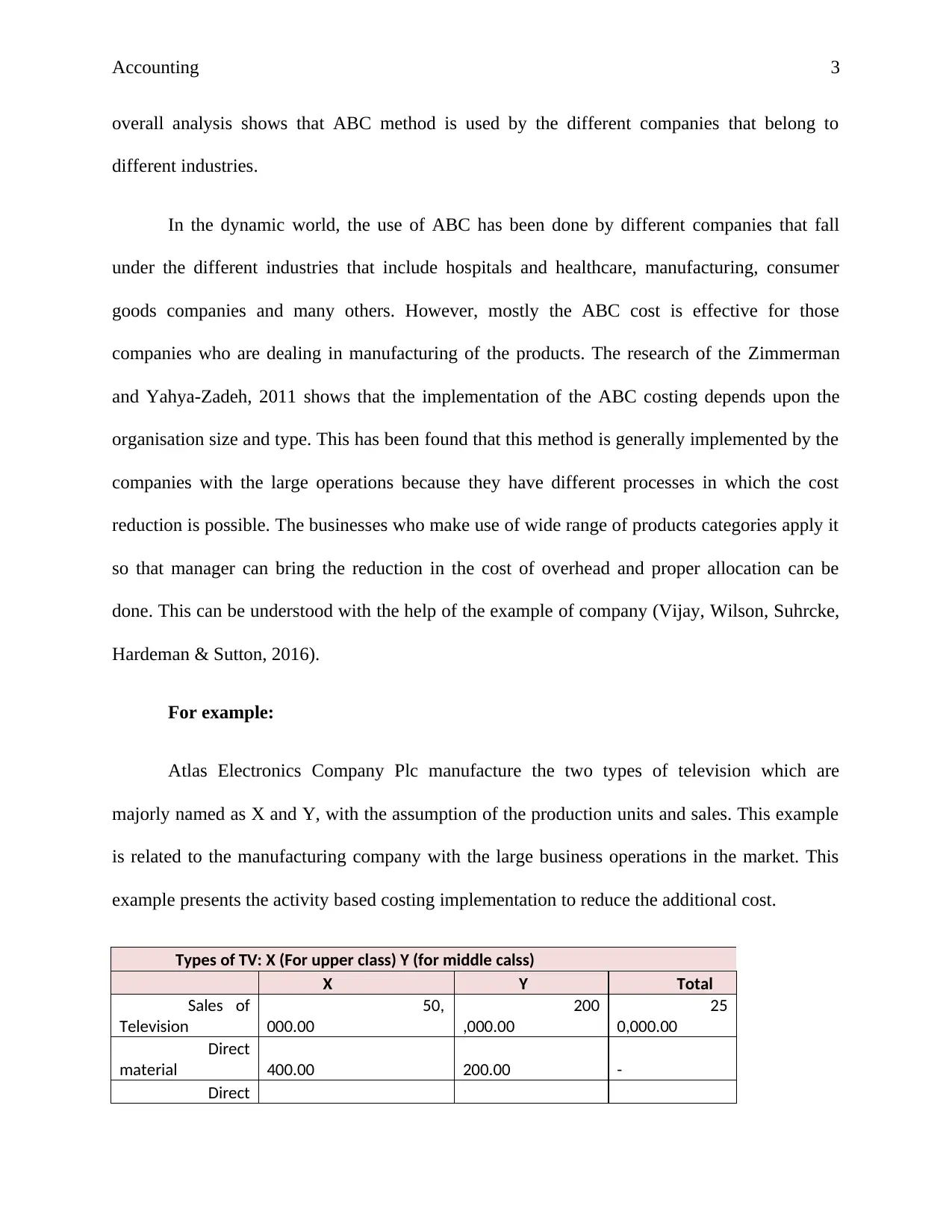
Accounting 3
overall analysis shows that ABC method is used by the different companies that belong to
different industries.
In the dynamic world, the use of ABC has been done by different companies that fall
under the different industries that include hospitals and healthcare, manufacturing, consumer
goods companies and many others. However, mostly the ABC cost is effective for those
companies who are dealing in manufacturing of the products. The research of the Zimmerman
and Yahya-Zadeh, 2011 shows that the implementation of the ABC costing depends upon the
organisation size and type. This has been found that this method is generally implemented by the
companies with the large operations because they have different processes in which the cost
reduction is possible. The businesses who make use of wide range of products categories apply it
so that manager can bring the reduction in the cost of overhead and proper allocation can be
done. This can be understood with the help of the example of company (Vijay, Wilson, Suhrcke,
Hardeman & Sutton, 2016).
For example:
Atlas Electronics Company Plc manufacture the two types of television which are
majorly named as X and Y, with the assumption of the production units and sales. This example
is related to the manufacturing company with the large business operations in the market. This
example presents the activity based costing implementation to reduce the additional cost.
Types of TV: X (For upper class) Y (for middle calss)
X Y Total
Sales of
Television
50,
000.00
200
,000.00
25
0,000.00
Direct
material 400.00 200.00 -
Direct
overall analysis shows that ABC method is used by the different companies that belong to
different industries.
In the dynamic world, the use of ABC has been done by different companies that fall
under the different industries that include hospitals and healthcare, manufacturing, consumer
goods companies and many others. However, mostly the ABC cost is effective for those
companies who are dealing in manufacturing of the products. The research of the Zimmerman
and Yahya-Zadeh, 2011 shows that the implementation of the ABC costing depends upon the
organisation size and type. This has been found that this method is generally implemented by the
companies with the large operations because they have different processes in which the cost
reduction is possible. The businesses who make use of wide range of products categories apply it
so that manager can bring the reduction in the cost of overhead and proper allocation can be
done. This can be understood with the help of the example of company (Vijay, Wilson, Suhrcke,
Hardeman & Sutton, 2016).
For example:
Atlas Electronics Company Plc manufacture the two types of television which are
majorly named as X and Y, with the assumption of the production units and sales. This example
is related to the manufacturing company with the large business operations in the market. This
example presents the activity based costing implementation to reduce the additional cost.
Types of TV: X (For upper class) Y (for middle calss)
X Y Total
Sales of
Television
50,
000.00
200
,000.00
25
0,000.00
Direct
material 400.00 200.00 -
Direct
Paraphrase This Document
Need a fresh take? Get an instant paraphrase of this document with our AI Paraphraser
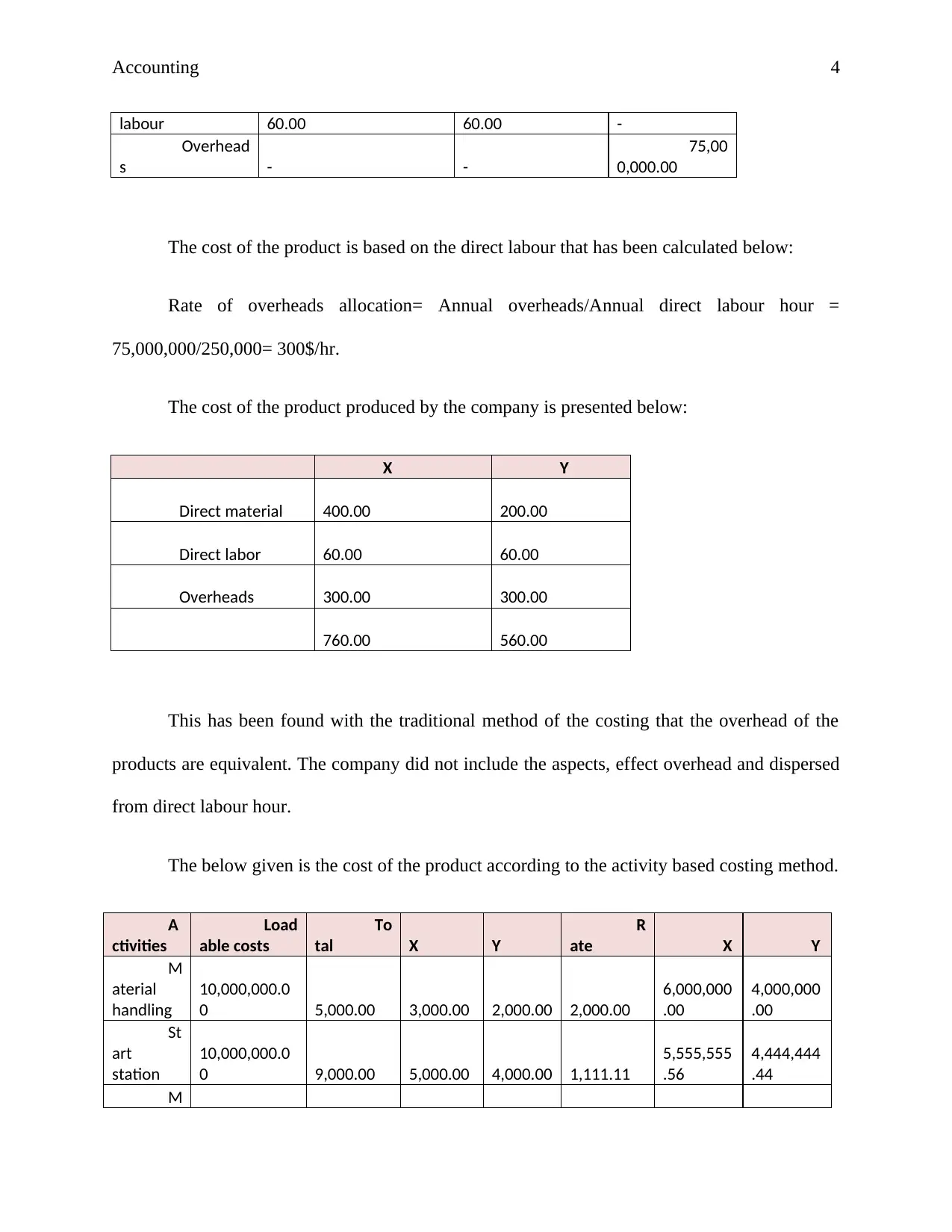
Accounting 4
labour 60.00 60.00 -
Overhead
s - -
75,00
0,000.00
The cost of the product is based on the direct labour that has been calculated below:
Rate of overheads allocation= Annual overheads/Annual direct labour hour =
75,000,000/250,000= 300$/hr.
The cost of the product produced by the company is presented below:
X Y
Direct material 400.00 200.00
Direct labor 60.00 60.00
Overheads 300.00 300.00
760.00 560.00
This has been found with the traditional method of the costing that the overhead of the
products are equivalent. The company did not include the aspects, effect overhead and dispersed
from direct labour hour.
The below given is the cost of the product according to the activity based costing method.
A
ctivities
Load
able costs
To
tal X Y
R
ate X Y
M
aterial
handling
10,000,000.0
0 5,000.00 3,000.00 2,000.00 2,000.00
6,000,000
.00
4,000,000
.00
St
art
station
10,000,000.0
0 9,000.00 5,000.00 4,000.00 1,111.11
5,555,555
.56
4,444,444
.44
M
labour 60.00 60.00 -
Overhead
s - -
75,00
0,000.00
The cost of the product is based on the direct labour that has been calculated below:
Rate of overheads allocation= Annual overheads/Annual direct labour hour =
75,000,000/250,000= 300$/hr.
The cost of the product produced by the company is presented below:
X Y
Direct material 400.00 200.00
Direct labor 60.00 60.00
Overheads 300.00 300.00
760.00 560.00
This has been found with the traditional method of the costing that the overhead of the
products are equivalent. The company did not include the aspects, effect overhead and dispersed
from direct labour hour.
The below given is the cost of the product according to the activity based costing method.
A
ctivities
Load
able costs
To
tal X Y
R
ate X Y
M
aterial
handling
10,000,000.0
0 5,000.00 3,000.00 2,000.00 2,000.00
6,000,000
.00
4,000,000
.00
St
art
station
10,000,000.0
0 9,000.00 5,000.00 4,000.00 1,111.11
5,555,555
.56
4,444,444
.44
M
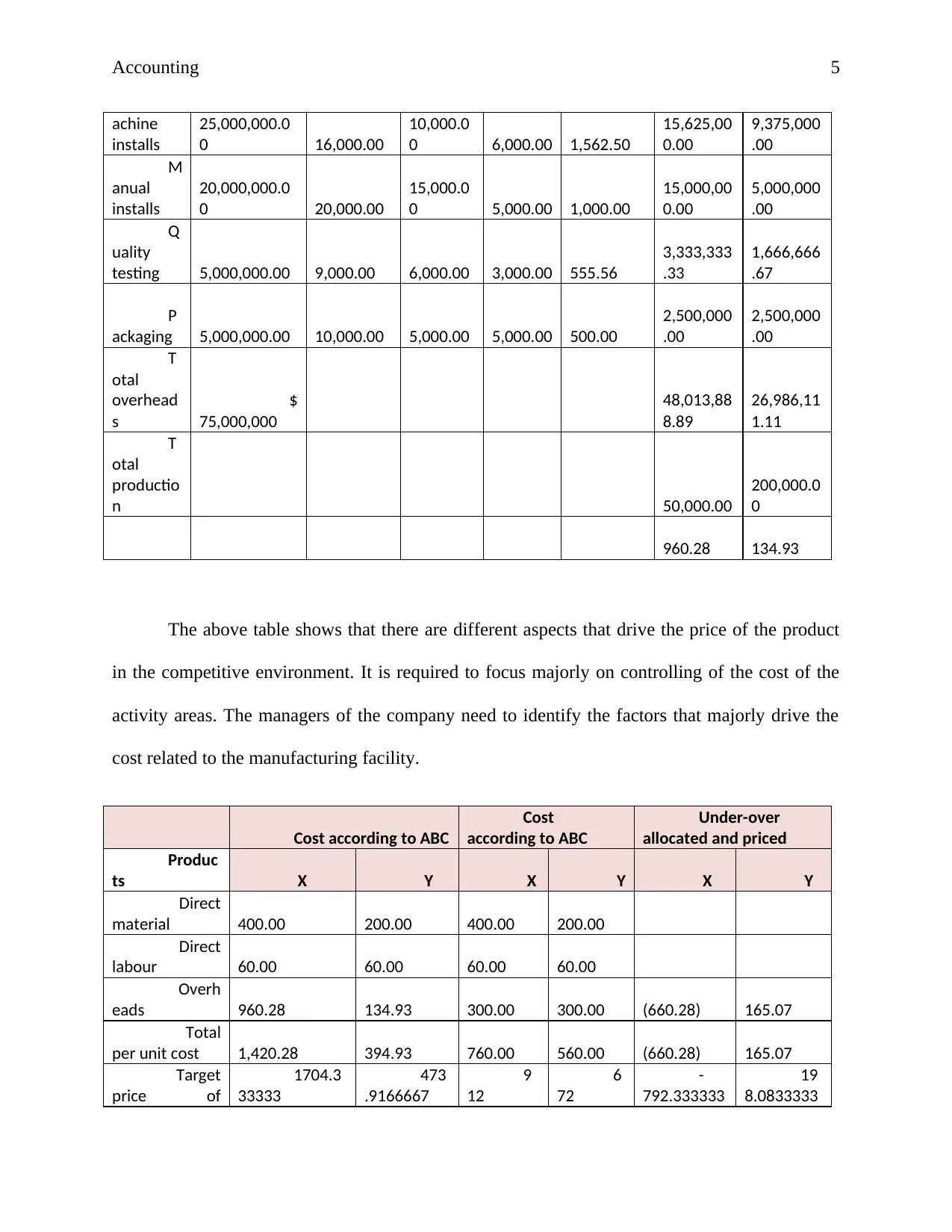
Accounting 5
achine
installs
25,000,000.0
0 16,000.00
10,000.0
0 6,000.00 1,562.50
15,625,00
0.00
9,375,000
.00
M
anual
installs
20,000,000.0
0 20,000.00
15,000.0
0 5,000.00 1,000.00
15,000,00
0.00
5,000,000
.00
Q
uality
testing 5,000,000.00 9,000.00 6,000.00 3,000.00 555.56
3,333,333
.33
1,666,666
.67
P
ackaging 5,000,000.00 10,000.00 5,000.00 5,000.00 500.00
2,500,000
.00
2,500,000
.00
T
otal
overhead
s
$
75,000,000
48,013,88
8.89
26,986,11
1.11
T
otal
productio
n 50,000.00
200,000.0
0
960.28 134.93
The above table shows that there are different aspects that drive the price of the product
in the competitive environment. It is required to focus majorly on controlling of the cost of the
activity areas. The managers of the company need to identify the factors that majorly drive the
cost related to the manufacturing facility.
Cost according to ABC
Cost
according to ABC
Under-over
allocated and priced
Produc
ts X Y X Y X Y
Direct
material 400.00 200.00 400.00 200.00
Direct
labour 60.00 60.00 60.00 60.00
Overh
eads 960.28 134.93 300.00 300.00 (660.28) 165.07
Total
per unit cost 1,420.28 394.93 760.00 560.00 (660.28) 165.07
Target
price of
1704.3
33333
473
.9166667
9
12
6
72
-
792.333333
19
8.0833333
achine
installs
25,000,000.0
0 16,000.00
10,000.0
0 6,000.00 1,562.50
15,625,00
0.00
9,375,000
.00
M
anual
installs
20,000,000.0
0 20,000.00
15,000.0
0 5,000.00 1,000.00
15,000,00
0.00
5,000,000
.00
Q
uality
testing 5,000,000.00 9,000.00 6,000.00 3,000.00 555.56
3,333,333
.33
1,666,666
.67
P
ackaging 5,000,000.00 10,000.00 5,000.00 5,000.00 500.00
2,500,000
.00
2,500,000
.00
T
otal
overhead
s
$
75,000,000
48,013,88
8.89
26,986,11
1.11
T
otal
productio
n 50,000.00
200,000.0
0
960.28 134.93
The above table shows that there are different aspects that drive the price of the product
in the competitive environment. It is required to focus majorly on controlling of the cost of the
activity areas. The managers of the company need to identify the factors that majorly drive the
cost related to the manufacturing facility.
Cost according to ABC
Cost
according to ABC
Under-over
allocated and priced
Produc
ts X Y X Y X Y
Direct
material 400.00 200.00 400.00 200.00
Direct
labour 60.00 60.00 60.00 60.00
Overh
eads 960.28 134.93 300.00 300.00 (660.28) 165.07
Total
per unit cost 1,420.28 394.93 760.00 560.00 (660.28) 165.07
Target
price of
1704.3
33333
473
.9166667
9
12
6
72
-
792.333333
19
8.0833333
⊘ This is a preview!⊘
Do you want full access?
Subscribe today to unlock all pages.

Trusted by 1+ million students worldwide
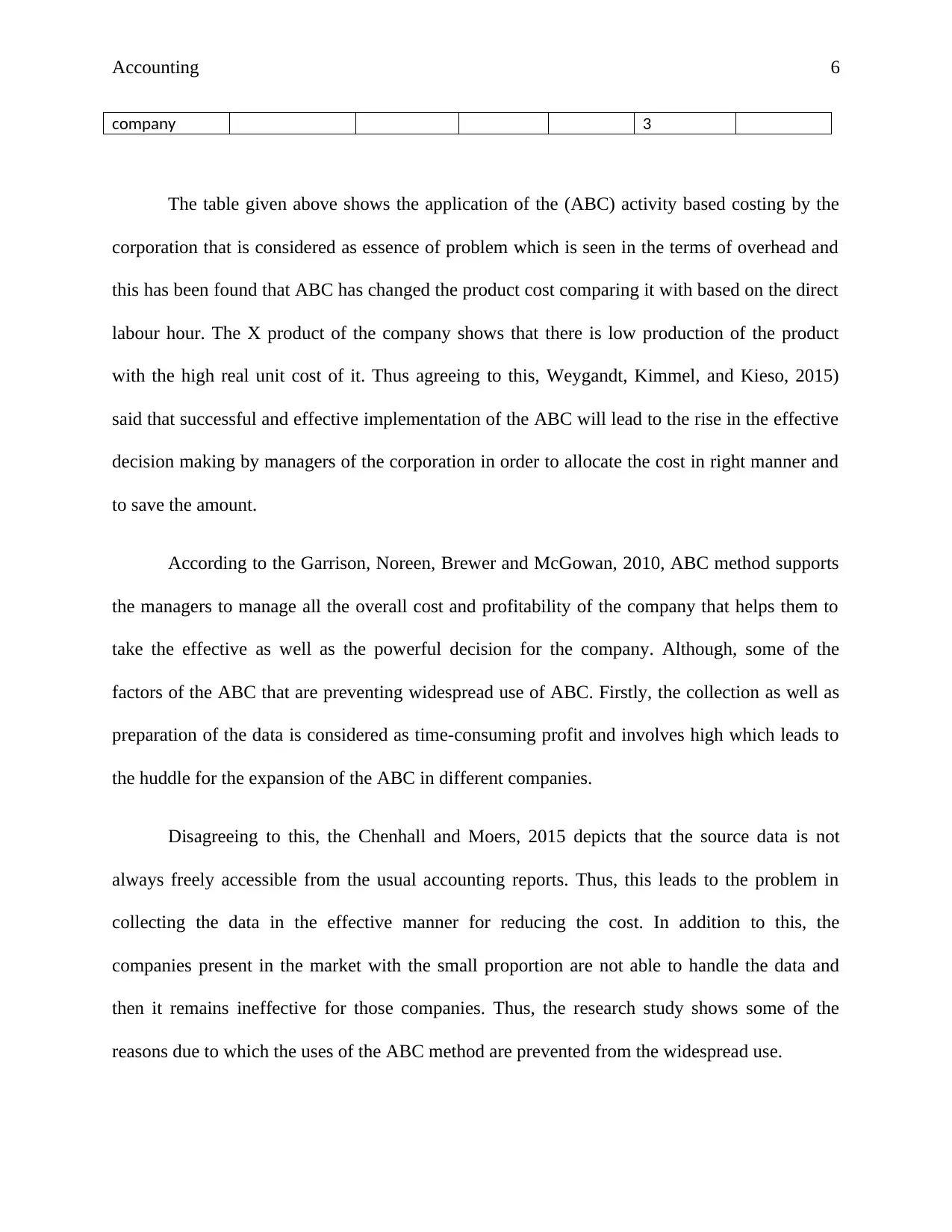
Accounting 6
company 3
The table given above shows the application of the (ABC) activity based costing by the
corporation that is considered as essence of problem which is seen in the terms of overhead and
this has been found that ABC has changed the product cost comparing it with based on the direct
labour hour. The X product of the company shows that there is low production of the product
with the high real unit cost of it. Thus agreeing to this, Weygandt, Kimmel, and Kieso, 2015)
said that successful and effective implementation of the ABC will lead to the rise in the effective
decision making by managers of the corporation in order to allocate the cost in right manner and
to save the amount.
According to the Garrison, Noreen, Brewer and McGowan, 2010, ABC method supports
the managers to manage all the overall cost and profitability of the company that helps them to
take the effective as well as the powerful decision for the company. Although, some of the
factors of the ABC that are preventing widespread use of ABC. Firstly, the collection as well as
preparation of the data is considered as time-consuming profit and involves high which leads to
the huddle for the expansion of the ABC in different companies.
Disagreeing to this, the Chenhall and Moers, 2015 depicts that the source data is not
always freely accessible from the usual accounting reports. Thus, this leads to the problem in
collecting the data in the effective manner for reducing the cost. In addition to this, the
companies present in the market with the small proportion are not able to handle the data and
then it remains ineffective for those companies. Thus, the research study shows some of the
reasons due to which the uses of the ABC method are prevented from the widespread use.
company 3
The table given above shows the application of the (ABC) activity based costing by the
corporation that is considered as essence of problem which is seen in the terms of overhead and
this has been found that ABC has changed the product cost comparing it with based on the direct
labour hour. The X product of the company shows that there is low production of the product
with the high real unit cost of it. Thus agreeing to this, Weygandt, Kimmel, and Kieso, 2015)
said that successful and effective implementation of the ABC will lead to the rise in the effective
decision making by managers of the corporation in order to allocate the cost in right manner and
to save the amount.
According to the Garrison, Noreen, Brewer and McGowan, 2010, ABC method supports
the managers to manage all the overall cost and profitability of the company that helps them to
take the effective as well as the powerful decision for the company. Although, some of the
factors of the ABC that are preventing widespread use of ABC. Firstly, the collection as well as
preparation of the data is considered as time-consuming profit and involves high which leads to
the huddle for the expansion of the ABC in different companies.
Disagreeing to this, the Chenhall and Moers, 2015 depicts that the source data is not
always freely accessible from the usual accounting reports. Thus, this leads to the problem in
collecting the data in the effective manner for reducing the cost. In addition to this, the
companies present in the market with the small proportion are not able to handle the data and
then it remains ineffective for those companies. Thus, the research study shows some of the
reasons due to which the uses of the ABC method are prevented from the widespread use.
Paraphrase This Document
Need a fresh take? Get an instant paraphrase of this document with our AI Paraphraser
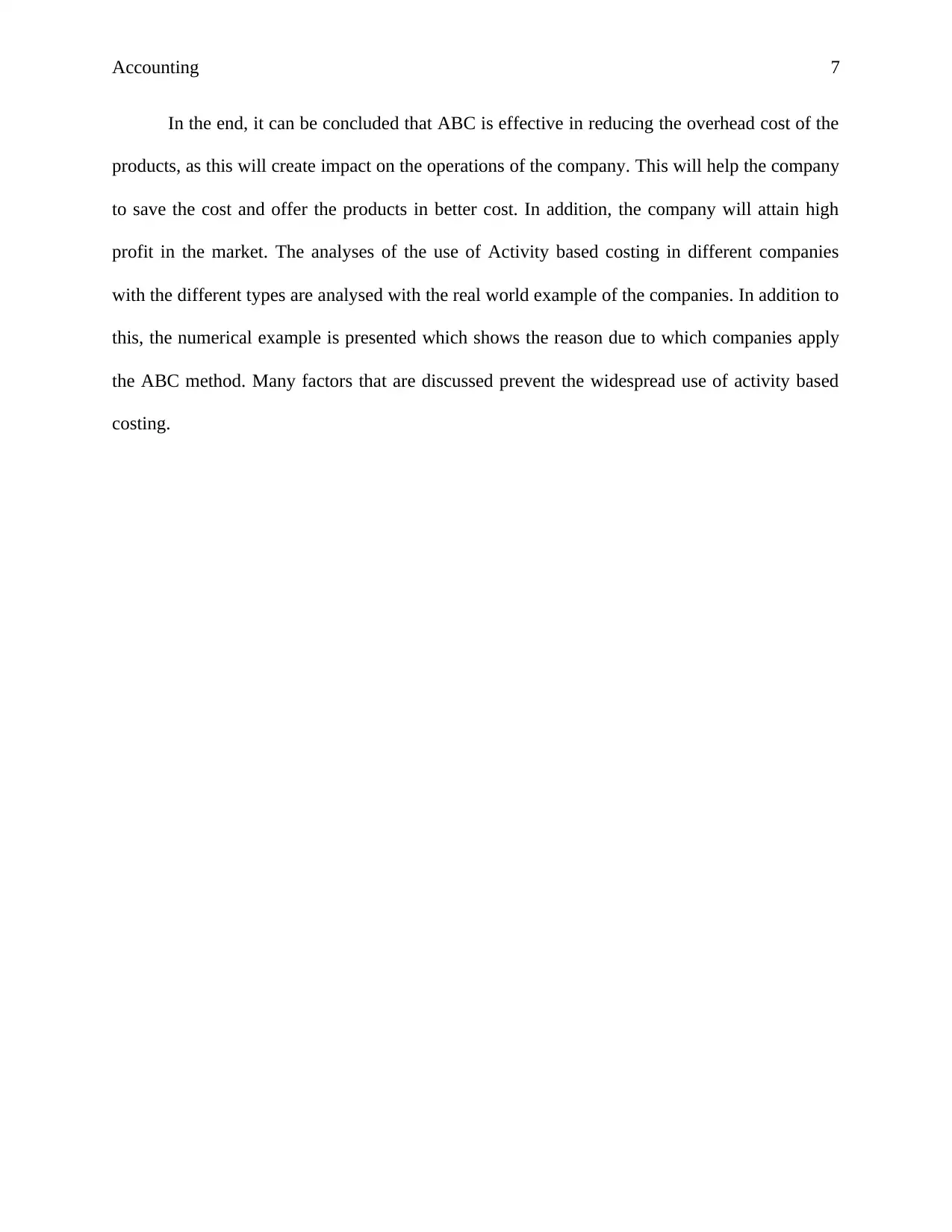
Accounting 7
In the end, it can be concluded that ABC is effective in reducing the overhead cost of the
products, as this will create impact on the operations of the company. This will help the company
to save the cost and offer the products in better cost. In addition, the company will attain high
profit in the market. The analyses of the use of Activity based costing in different companies
with the different types are analysed with the real world example of the companies. In addition to
this, the numerical example is presented which shows the reason due to which companies apply
the ABC method. Many factors that are discussed prevent the widespread use of activity based
costing.
In the end, it can be concluded that ABC is effective in reducing the overhead cost of the
products, as this will create impact on the operations of the company. This will help the company
to save the cost and offer the products in better cost. In addition, the company will attain high
profit in the market. The analyses of the use of Activity based costing in different companies
with the different types are analysed with the real world example of the companies. In addition to
this, the numerical example is presented which shows the reason due to which companies apply
the ABC method. Many factors that are discussed prevent the widespread use of activity based
costing.
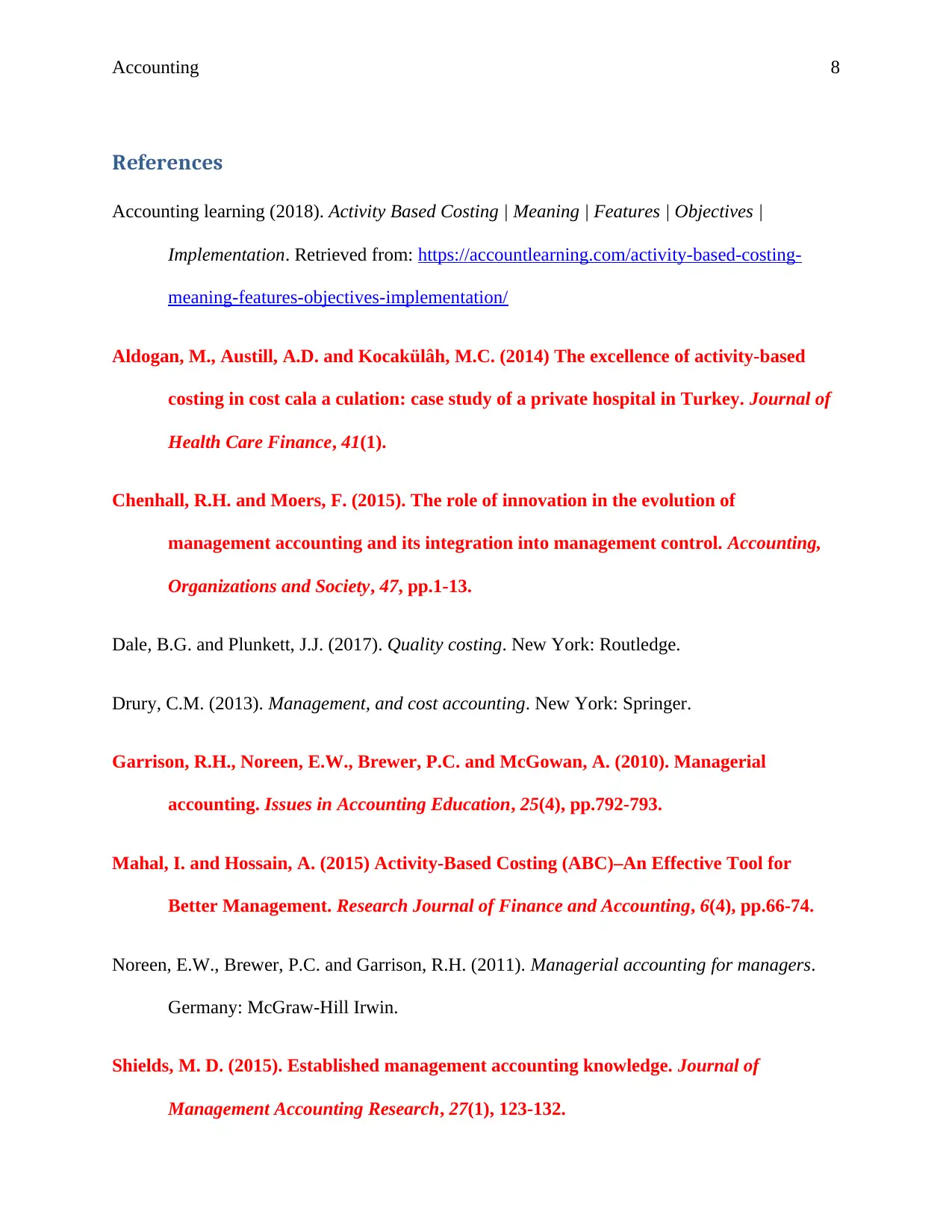
Accounting 8
References
Accounting learning (2018). Activity Based Costing | Meaning | Features | Objectives |
Implementation. Retrieved from: https://accountlearning.com/activity-based-costing-
meaning-features-objectives-implementation/
Aldogan, M., Austill, A.D. and Kocakülâh, M.C. (2014) The excellence of activity-based
costing in cost cala a culation: case study of a private hospital in Turkey. Journal of
Health Care Finance, 41(1).
Chenhall, R.H. and Moers, F. (2015). The role of innovation in the evolution of
management accounting and its integration into management control. Accounting,
Organizations and Society, 47, pp.1-13.
Dale, B.G. and Plunkett, J.J. (2017). Quality costing. New York: Routledge.
Drury, C.M. (2013). Management, and cost accounting. New York: Springer.
Garrison, R.H., Noreen, E.W., Brewer, P.C. and McGowan, A. (2010). Managerial
accounting. Issues in Accounting Education, 25(4), pp.792-793.
Mahal, I. and Hossain, A. (2015) Activity-Based Costing (ABC)–An Effective Tool for
Better Management. Research Journal of Finance and Accounting, 6(4), pp.66-74.
Noreen, E.W., Brewer, P.C. and Garrison, R.H. (2011). Managerial accounting for managers.
Germany: McGraw-Hill Irwin.
Shields, M. D. (2015). Established management accounting knowledge. Journal of
Management Accounting Research, 27(1), 123-132.
References
Accounting learning (2018). Activity Based Costing | Meaning | Features | Objectives |
Implementation. Retrieved from: https://accountlearning.com/activity-based-costing-
meaning-features-objectives-implementation/
Aldogan, M., Austill, A.D. and Kocakülâh, M.C. (2014) The excellence of activity-based
costing in cost cala a culation: case study of a private hospital in Turkey. Journal of
Health Care Finance, 41(1).
Chenhall, R.H. and Moers, F. (2015). The role of innovation in the evolution of
management accounting and its integration into management control. Accounting,
Organizations and Society, 47, pp.1-13.
Dale, B.G. and Plunkett, J.J. (2017). Quality costing. New York: Routledge.
Drury, C.M. (2013). Management, and cost accounting. New York: Springer.
Garrison, R.H., Noreen, E.W., Brewer, P.C. and McGowan, A. (2010). Managerial
accounting. Issues in Accounting Education, 25(4), pp.792-793.
Mahal, I. and Hossain, A. (2015) Activity-Based Costing (ABC)–An Effective Tool for
Better Management. Research Journal of Finance and Accounting, 6(4), pp.66-74.
Noreen, E.W., Brewer, P.C. and Garrison, R.H. (2011). Managerial accounting for managers.
Germany: McGraw-Hill Irwin.
Shields, M. D. (2015). Established management accounting knowledge. Journal of
Management Accounting Research, 27(1), 123-132.
⊘ This is a preview!⊘
Do you want full access?
Subscribe today to unlock all pages.

Trusted by 1+ million students worldwide
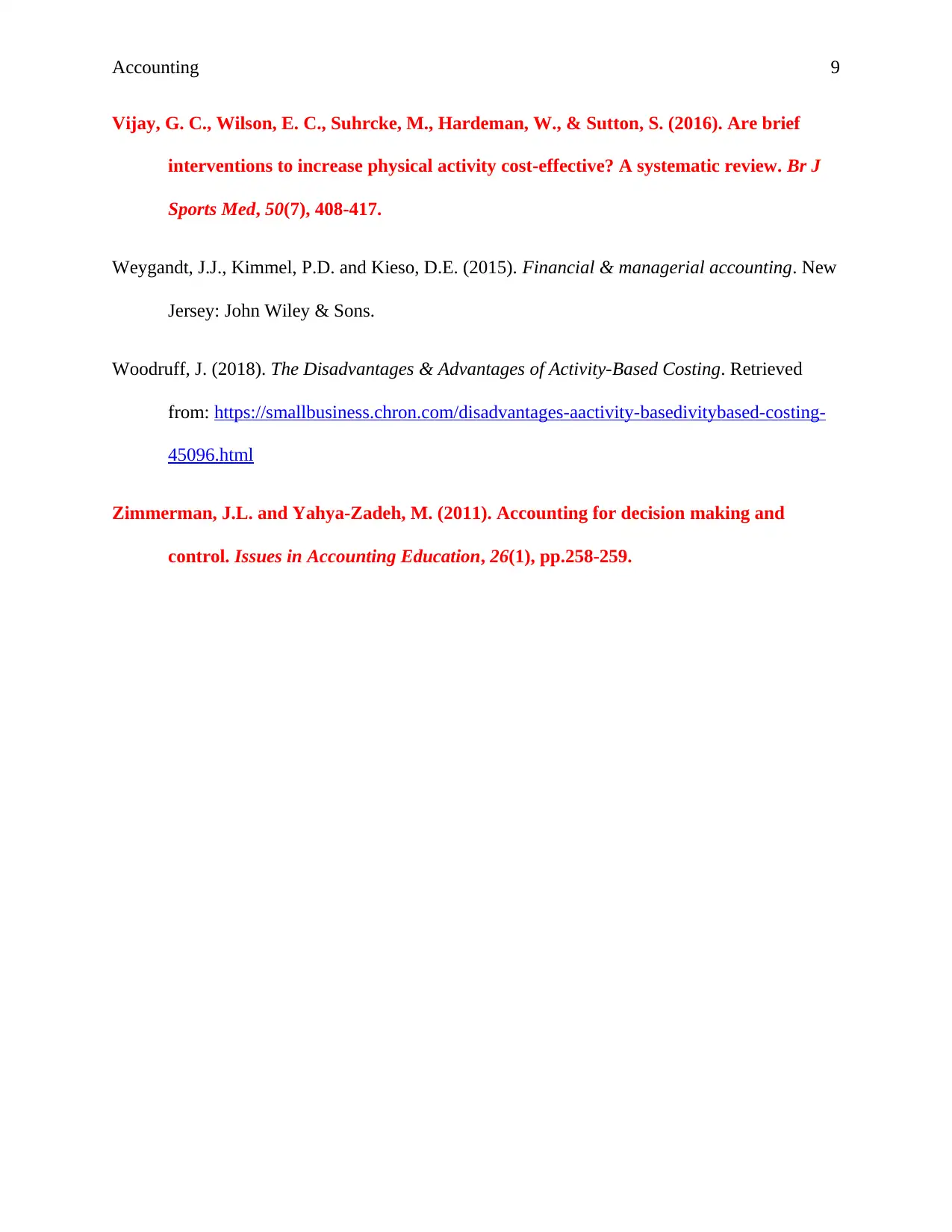
Accounting 9
Vijay, G. C., Wilson, E. C., Suhrcke, M., Hardeman, W., & Sutton, S. (2016). Are brief
interventions to increase physical activity cost-effective? A systematic review. Br J
Sports Med, 50(7), 408-417.
Weygandt, J.J., Kimmel, P.D. and Kieso, D.E. (2015). Financial & managerial accounting. New
Jersey: John Wiley & Sons.
Woodruff, J. (2018). The Disadvantages & Advantages of Activity-Based Costing. Retrieved
from: https://smallbusiness.chron.com/disadvantages-aactivity-basedivitybased-costing-
45096.html
Zimmerman, J.L. and Yahya-Zadeh, M. (2011). Accounting for decision making and
control. Issues in Accounting Education, 26(1), pp.258-259.
Vijay, G. C., Wilson, E. C., Suhrcke, M., Hardeman, W., & Sutton, S. (2016). Are brief
interventions to increase physical activity cost-effective? A systematic review. Br J
Sports Med, 50(7), 408-417.
Weygandt, J.J., Kimmel, P.D. and Kieso, D.E. (2015). Financial & managerial accounting. New
Jersey: John Wiley & Sons.
Woodruff, J. (2018). The Disadvantages & Advantages of Activity-Based Costing. Retrieved
from: https://smallbusiness.chron.com/disadvantages-aactivity-basedivitybased-costing-
45096.html
Zimmerman, J.L. and Yahya-Zadeh, M. (2011). Accounting for decision making and
control. Issues in Accounting Education, 26(1), pp.258-259.
1 out of 10
Related Documents
Your All-in-One AI-Powered Toolkit for Academic Success.
+13062052269
info@desklib.com
Available 24*7 on WhatsApp / Email
![[object Object]](/_next/static/media/star-bottom.7253800d.svg)
Unlock your academic potential
Copyright © 2020–2025 A2Z Services. All Rights Reserved. Developed and managed by ZUCOL.





